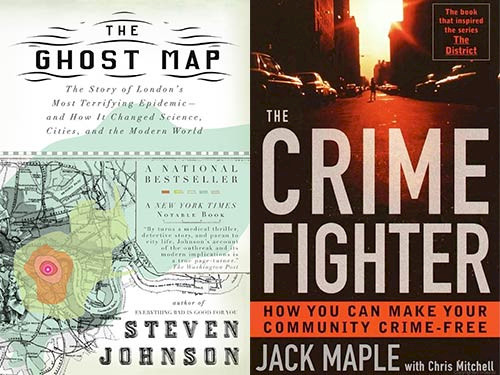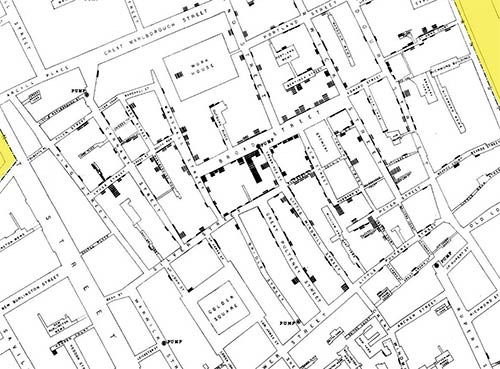Dr. John Snow and Jack Maple, kindred spirits
Bill Dennison ·Dr. John Snow (1813-1858) was a doctor who lived in London, England and Jack Maple (1952-2001) was a policeman who lived in New York City, USA. In spite of their wide geographical and generational differences, these two remarkable men were kindred spirits in combining insights and good maps to solve compelling problems. Following their premature deaths, both men have developed a strong following and have left a legacy that transcended their lives. Two wonderful books recount their achievements; "The Ghost Map: The Story of London's Most Terrifying Epidemic - and How it Changed Science, Cities and the Modern World", written by Steven Johnson in 2006, and "The Crime Fighter: How You Can Make Your Community Crime Free", written by Jack Maple and Chris Mitchell in 1999.

Dr. John Snow constructed a famous map, which depicted the locations of deaths due to an outbreak of cholera in 1854 in London and included the locations of the drinking water wells. John Snow's genius was discerning the link between drinking water supply and fatalities and effectively communicating this link. Snow chose to display two data sources; locations of fatalities and pumps. From the map, it was abundantly clear that there was a relationship between the Broad Street pump and fatalities. This map was used to elicit the appropriate action--removal of the Broad Street pump handle so that London residents were directed to other drinking water sources. The cholera epidemic subsided and John Snow has been credited as being the founder of modern epidemiology. There is a John Snow Society and several tributes to him continue to this day, including an annual pump handle removal ceremony.

Jack Maple constructed maps of crime in New York City in the 1990s and used these maps to deploy police for crime fighting. His approach proved to be successful for reducing crime in New York City transit systems, particularly subways, and under the leadership of Police Commissioner William Bratton, was expanded to the large New York City police department in a program called CompStat, short for Computer Statistics. Maple outlined four principles of using a 'stat-ing' approach as the following:
1) Accurate, timely intelligence that is clearly communicated to all, 2) Rapid deployment that is concentrated, synchronized and focused, 3) Effective tactics, and 4) Relentless follow-up and assessment. Jack Maple's approach has been used by police departments around the world, and has been expanded to include a wide array of government services.
Both John Snow and Jack Maple were visionaries who were incredibly focused on their respective professional challenges. They were also 'quirky' guys who had interesting personality traits. For example, John Snow studied the anesthetic properties of ether by self administering it to himself and recording how long he was knocked out, Jack Maple wore a homburg hat, two tone shoes and bow tie, and his preferred drink was champagne on ice. In spite of their modest means and origins, they rubbed shoulders with the high and mighty. Dr. Snow administered ether to Queen Victoria during the delivery of several of her children. Jack Maple was eulogized by New City Mayor Rudy Guilliani and socialized with the New York City elite at a famous restaurant, Elaine's.
What John Snow and Jack Maple did was revolutionary in their respective fields, and the impacts of their approach transcended the specific applications of public health and public safety to which they applied logic and maps. It is the clarity of thought and power of communication that is so attractive about their approaches to fighting disease and crime. They literally saved lives with their insights and inspired other practitioners to strive for similar positive results. Their legacies can be found in the practice of using evidence based decisions around the world.
About the author
Bill Dennison

Dr. Bill Dennison is a Professor of Marine Science and Vice President for Science Application at the University of Maryland Center for Environmental Science.

